#apocynum cannabinum
Explore tagged Tumblr posts
Text










More night flowers
#landscape#landscape photography#nature#nature photography#naturecore#photography#flowers#wildflowers#meadow#spring#beardtongue#penstemon#spiderwort#tradescantia#aster#daisy#allium#wild garlic#dogwood#cornus#dogbane#apocynum#apocynum cannabinum#clover#trifolium#milkweed#asclepias#ruellia#petunia#kentucky
28 notes
·
View notes
Text
"It is poisonous to humans,[5] dogs, cats, and horses.[13] All parts of the plant are toxic, and the plant contains cardiac glycosides.[5] The plant is toxic both green and dried.[14] The stems contain a white sap capable of causing skin blisters.[15]"
Tracking down the sources (5) leads to https://pfaf.org/user/Plant.aspx?LatinName=Apocynum+cannabinum, which in turn cites four sources for its toxicity at https://pfaf.org/user/cmspage.aspx?pageid=174 (1, 4, 19, 62).
Checking out one of those sources (62, from 1982), found it on Anna's archive: https://annas-archive.org/md5/3e8a8a8148cbc2c2afb4b960614a0a87 (also borrowable from IA, though it's timing out for me: https://archive.org/details/fieldguidetonort0000elia/page/282/mode/2up ).

Not exactly super helpful -__- Doing a search on Anna's Archive for just "dogbane" does give this scholarly source though: "Medical Toxicology of Natural Substances || Dogbane Family and Cardenolides" (10.1002/9780470330319.ch147) (https://annas-archive.org/md5/1e3c8186cfe91266972a50468f0fe835).
"The most commonly mentioned folk use was as an abortifacient."
(Well that's a fun side-quest; back to what/how it's poisonous)
"Common oleander contains several cardiac glycosides (oleandrin, digitoxigenin, neriantin, rosagenin) that produce a digitoxin- like effect by inhibiting the sodium - potassium adenosine triphosphatase enzyme system. These cardiac glycosides bind to an extracellular portion of the Na + /K + ATPases and cause increased intracellular calcium concentrations. Minor glycosides in oleander with limited cardiac activity include adynerigenin, adigoside, digitalin, and uzarigenin.11 Because of the lack of toxicokinetics data, the identities of the toxic glycosides or toxic metabolites remain unclear."
"Of over 400 cardiac glycosides isolated from the plant kingdom, most of the cardiac glycosides occur in extracts from the milkweed (Asclepiadaceae), figwort (Scrophulariaceae), lily (Liliaceae), and dogbane (Apocynaceae) families. The highest concentrations of cardiac glycosides are found in seed, stems, and roots, followed by the fruit and leaves. However, the leaves contain the greatest oleandrin concentrations. The concentration of oleandrin varies widely between various strains and species of oleander."
"Oleander poisoning resembles digitoxin poisoning with the predominant symptoms involving the gastrointestinal and cardiac systems. Serious oleander intoxication usually occurs following the ingestion of teas prepared from oleander leaves rather than from the ingestion of plant parts.21 – 23 The bitter taste of the oleander leaves limits the ingestion of oleander leaves in children. Characteristic features of serious oleander poisoning include confusion, marked hyperkalemia, conduction abnormalities, and ventricular arrhythmias. Nausea and vomiting usually occur within several hours, and gastrointestinal symptoms are more prominent following oleander poisoning than following digoxin toxicity. Increased salivation, dry mouth, burning of the mouth, and paraesthesias of the tongue may develop as a result of the local effects of oleander extracts.22 Case reports indicate that the astringent properties of oleander sap produce mucosal irritation.24 The most common serious complication of oleander poisoning is disruption of cardiac conduction.25 Cardiogenic shock, ventricular fibrillation, and cardiovascular collapse may occur following severe oleander toxicity. Conduction delays may persist 3– 6 days, and these cardiac effects resemble classical digitalis toxicity (e.g., conduction abnormalities with ectopy, such as supraventricular tachycardia with atrioventricular block).23,26"
Alright. So... definitely don't eat off of it, and definitely don't make tea with it (the source mentions a case where tea was purposely prepared and ingested, presumably as a suicide attempt). But assuming you aren't trying to ingest it... then sure? It's probably safe as a base for textiles? I suppose the biggest risk would be the textile getting wet and leaching cardiac glycosides, assuming that those glycosides remain in sufficient quantity after processing the stems.
"Although one leaf has been considered potentially lethal, ingestion of larger amounts is probably necessary to produce serious toxicity. Using calculations on the digoxin pharmacokinetic in the antemortem serum from a 96 - year- old woman who died after ingesting oleander tea, Osterloh et al estimated that the apparent digoxin concentration of 5.8 ng/mL was equivalent to the absorption of cardiac glycosides from 5– 15 Nerium leaves.19 The postmortem examination did not demonstrate any evidence of coronary artery disease. Using a crude oleander extract prepared by ethanol extraction, lead acetate purification, and solvent partition, the group estimated that 100 ng/mL of crude extract produced a 1 ng/mL false elevation of the digoxin concentration. Assuming the Vd of digitoxin was 1 L/kg, the estimated absorbed dose of cardiac glycosides was approximately 4 grams, which was equivalent to 5– 15 oleander leaves."
Hmmm. The leaves have greater concentrations than the stems according to the source, so... probably not a huge risk unless you're recycling water without treating it? Or perhaps during the processing of the plant, those that do the processing might consider it an occupational hazard? I mean, if you wanted to have large crops of it, then I'd imagine you'd need certain precautions when processing on an industrial scale.
I mean, at this point, I'm invested and wanna read more. @headspace-hotel, what sources do you have for "In terms of the quality and usefulness of fiber and the amount you get out of it relative to the amount of work it just blows everything else out of the water"? I figure there's a reason that cotton ended up the most used fiber of the textile industry and not any other.
Also @therobotmonster, @teeth-and-spackle, @oldmanyellsatcloud, @cryptidroots, @ilovemosss, probably several other folks that seemed interested in this that I've missed (can't scroll through the reblogs forever).
also I ended up looking at stuff about soviet agricultural experiments and apparently dogbane (Apocyonum cannabinum) was introduced to the USSR as a fiber crop plant? ???
#politics#tech#dogbane#textiles#ussr#apocyonum cannabinum#apocynum cannabinum#abortion#abortifacient#abortifacients#call me mark watney how i be doing botany for fun#botany
6K notes
·
View notes
Text
Hot And Dry Wildflower Walk, 6-4-23
Leucanthemum vulgare (Oxeye Daisy) on 6-4-23, #943-60. Hello, everyone! I hope this post finds you well. I decided to go for a wildflower walk on Sunday afternoon even though it was bright and sunny and the temperature was already almost 90° F. There was a nice breeze, so it wasn’t so bad. We haven’t had much rain and it seems many of the wildflowers I usually see are non-existent. Only the…
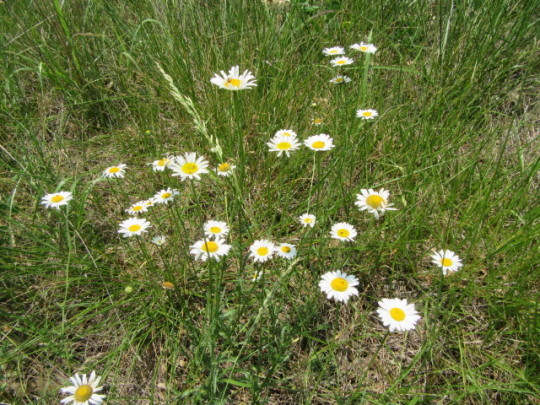
View On WordPress
#Achillea millefolium (Common Yarrow)#Allium vineale (Field or Wild Garlic)#Apocynum cannabinum (Hemp Dogbane)#Argynnis cybele (Great Spangled Fritillary)#Asclepias purpurascens (Purple Milkweed)#Conium maculatum (Poison Hemlock)#Cornus drummondii (Roughleaf Dogwood)#Dianthus armeria (Deptford Pink)#Dichanthelium clandestinum (Deertongue)#Elephantopus carolinianus (Leafy Elephant&039;s Foot)#Elmus virginicus (Virginia Wildrye)#Erigeron annuus (Annual or Daisy Fleabane)#Florinda coccinea (Black-tailed Red Sheetweaver)#Galium aparine (Cleavers/Catchweed Bedstraw)#Helenium flexuosum (Southern Sneezeweed)#Leucanthemum vulgare (Oxeye Daisy)#Penstemon digitalis (Foxglove Beardtongue)#Phytolacca americana (American Pokeweed)#Pontia protodice (Checkered White)#Potentilla simplex (Common Cinquefoil)#Ribes missouriense (Missouri Gooseberry#Sanicula canadensis (Black Snakeroot)#Sisymbrium officinale (Hedge Mustard)#Smilax tamnoides (Bristly Greenbriar)#Verbesina virginica (White Crownbeard/Frostweed)
0 notes
Text

I’m testing different methods of hemp dogbane fiber extraction! Apocynum cannabinum is a perennial plant related to milkweed that was (and still is!) used by native people across North America to make cordage. And there is a little patch of it growing right next to my house, huzzah! The jar with a red dot has some pectinase in it, the jar with a blue dot contains only water. I am so dang excited to see what kind of fiber we can obtain using different retting methods!
4 notes
·
View notes
Text
Eating the Spring Shoots of Dog-Strangling Vine--An Experiment
**WARNING** Every member of the milkweed family is poisonous. Some members, including all milkweeds (Asclepias) are edible after cooking, though some need more thorough cooking than others. Beginning foragers should absolutely not try this. More experienced foragers do so at their own risk.
Invasive species are everywhere. They differ from naturalized non-native plants in that they negatively impact the environment outside their native range. Dandelions, for example are not invasive in many places despite their numbers. But dog-strangling vine (Vincetoxicum) most certainly is. Its roots release a chemical in the ground that is poisonous to other plants and it's just close enough to the milkweeds to fool the monarch butterflies into laying their eggs on them, but the hatchlings then starve because they can't eat them. Garlic mustard is another invasive plant in North America and it also releases chemicals in the soil, but it's a perfectly edible plant and could in theory be eaten out of existence. Pity the same isn't true of dog-strangling vine--or is it?
The dogbanes (Apocynum) are another genus in the milkweed family and are known to be much more poisonous than milkweeds typically are (again, some are more poisonous than others). Yet there are edible uses for hemp dogbane (Apocynum cannabinum). It just happens to involve more preparation than, say, common milkweed (Asclepias syriaca).
I'm unaware of anyone dying from consuming dog-strangling vine, unlike lily-of-the-valley, yet another invasive species, which has killed people. In fact I couldn't find evidence of anyone eating it at all. I'm sure I can't have been the first to try, but if it's ever been recorded that information is not easily accessible.
I've read a lot about preparation of poisonous plants into edible vegetables and what I found in common is that young shoots seem to be the safest and generally you boil them (some in several changes of water). Pokeweed, for example, is deadly poisonous but for the young shoots in spring before the stems turn red. In that stage you can cook and eat them, and they used to be harvested fairly regularly and canned and sold in grocery stores.
So my plan was that I would try just a little to start and see if I got sick or had any worrying symptoms and work my way up. This is what I started with:
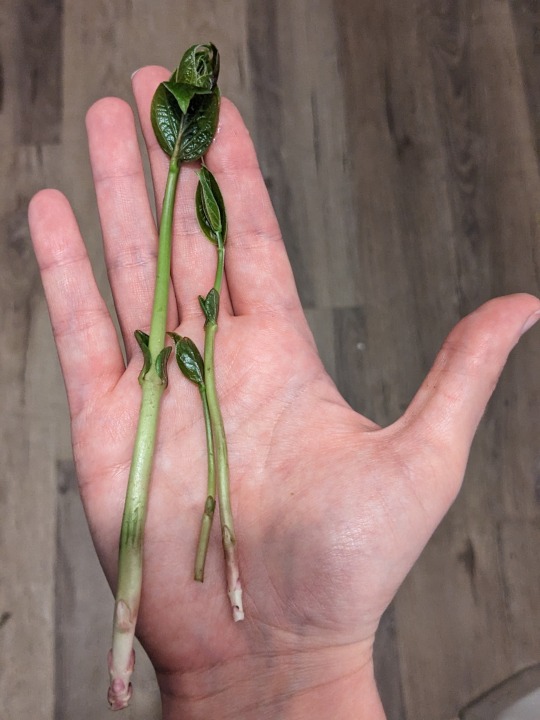
Just three little shoots from the garden. I fried them up until tender and crispy, at which point they also smelled quite nice, kind of a mix of asparagus and spinach, where before they had an unpleasant chemical smell. The taste was quite nice too. A sweet asparagus flavour. No symptoms after waiting a week.
That gave me some confidence because frying is considerably less thorough than boiling is and yet no adverse reaction. So the next step was to try a handful:
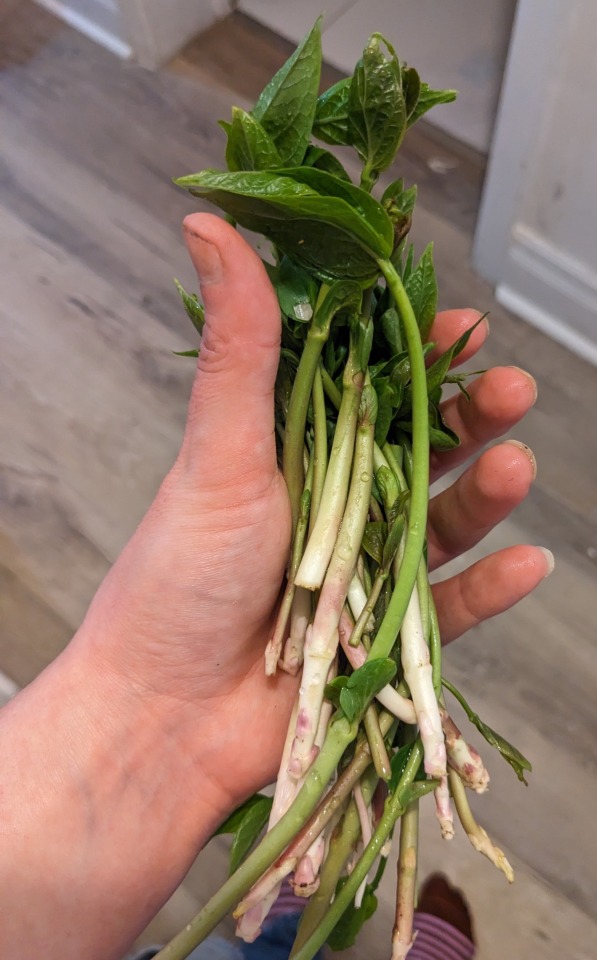
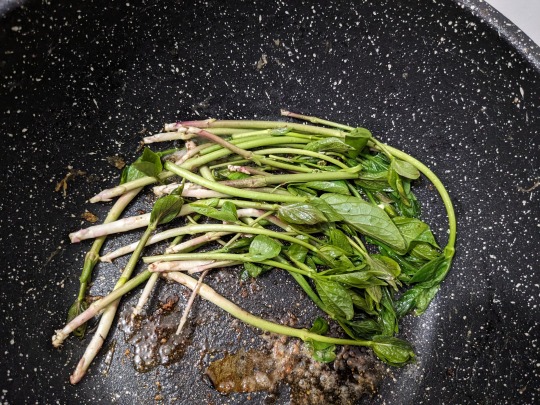
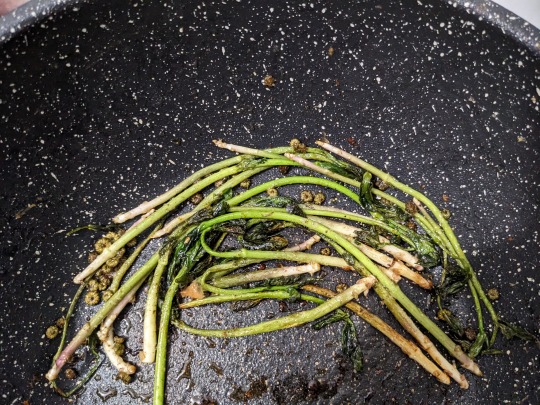
Since these were somewhat older I had to cut the ends off some of them, as you would asparagus. Cooked them longer and on higher heat, just in case. Also threw in some daisy buds. Same asparagus spinach smell, same sweet asparagus flavour. And again, no symptoms.
I waited a little over a week and then it was time for the final stage:
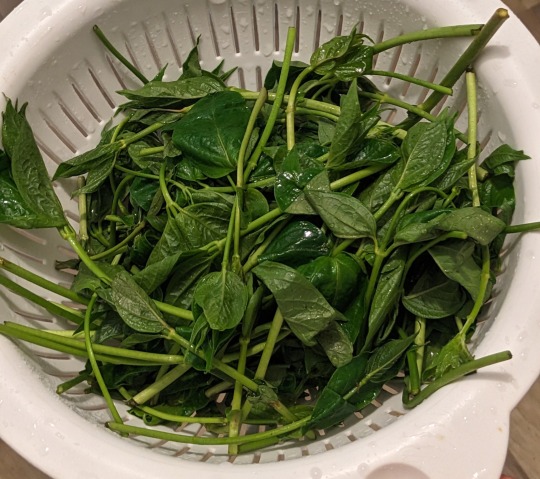
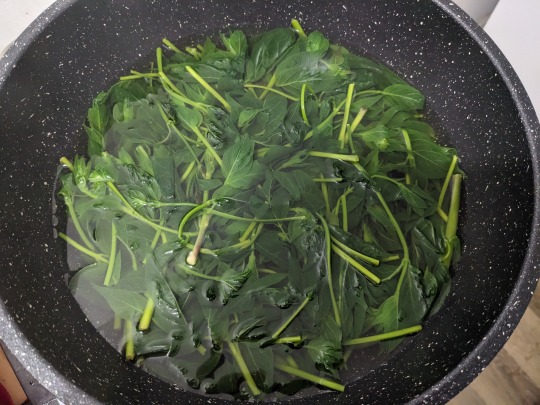
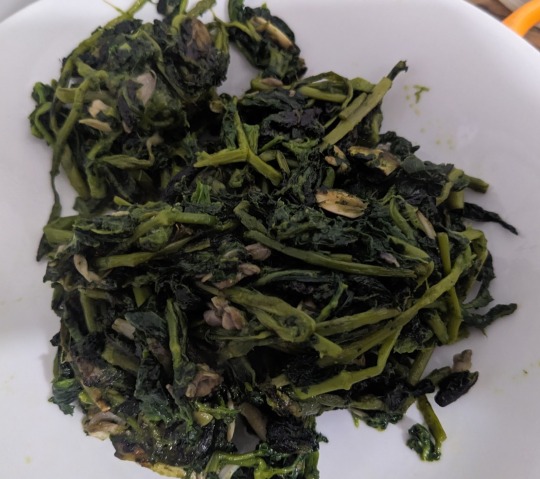
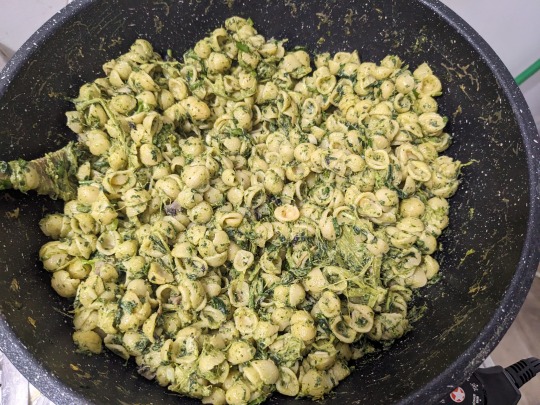
This time I did boil them, since I didn't want to play fuck around and find out *that* much. I then fried them up with some mushrooms I'd collected that day and then I mixed it all into some Annie's pasta, along with fresh invasive onions from the ravine. The final result was enough for three meals' worth, so I had a third for dinner, more for lunch the next day, and the rest for lunch the following day. It's now over 24 hours since yesterday's lunch. No symptoms.
This doesn't make it generally edible. I am a data point of one. What I can say is that, at least for some people this plant can be consumed young if cooked thoroughly with no short-term ill effects. Note that some people are able to eat the poisonous mushroom species of the Agaricus genus with no symptoms. They're still poisonous mushrooms.
The point is it's promising! I have shown it is *possible*. If other brave people who exercise appropriate caution eventually have similar results then, well, anecdata becomes data. :)
For my part I will definitely be adding this plant to my mental list of spring vegetables that require thorough cooking.
#experimenting with wild plants#don't try this at home#dog-strangling vine#foraging#Vincetoxicum#poisonous plants#experiments eating invasive species#poison risk
9 notes
·
View notes
Text
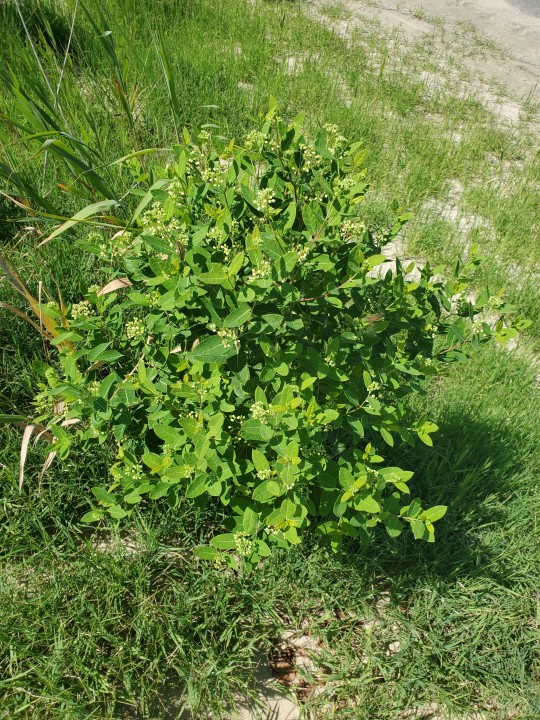
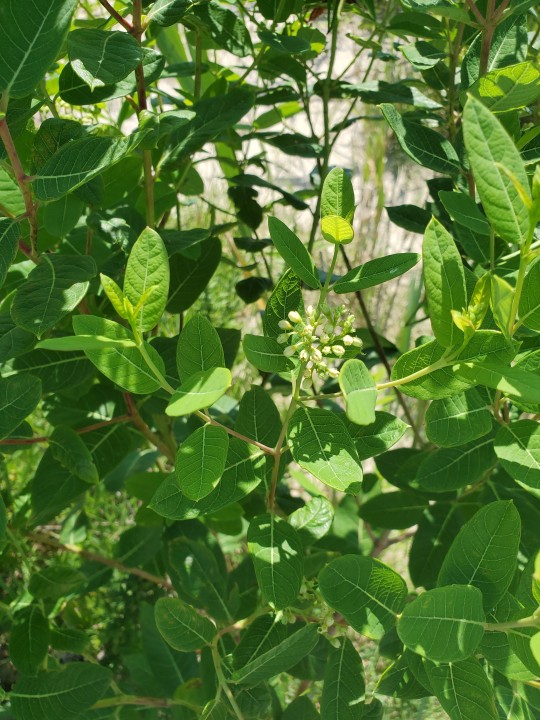
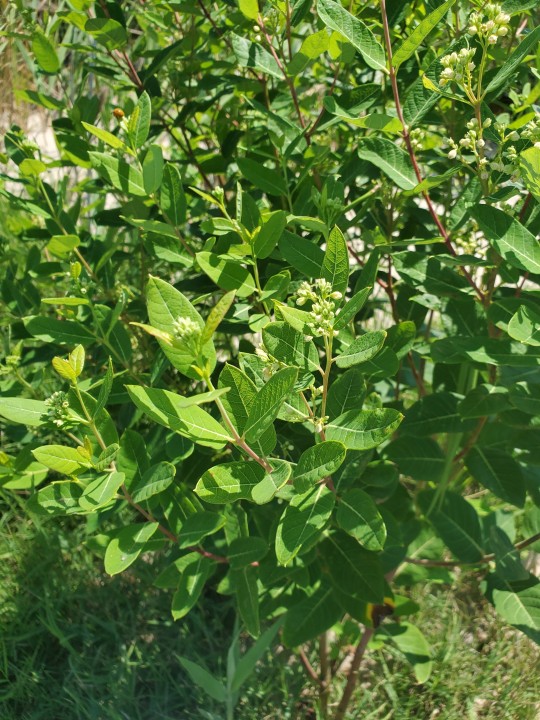

Hemp Dogbane (flowering & fruiting), Apocynum cannabinum
8 notes
·
View notes
Text

Apocynum cannabinum by Noah Yawn
0 notes
Photo

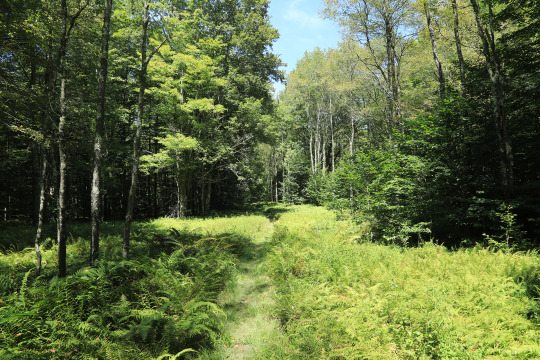
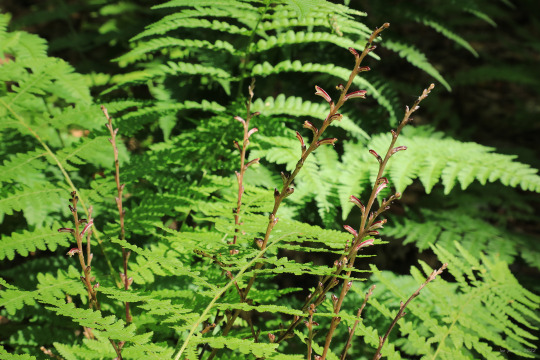
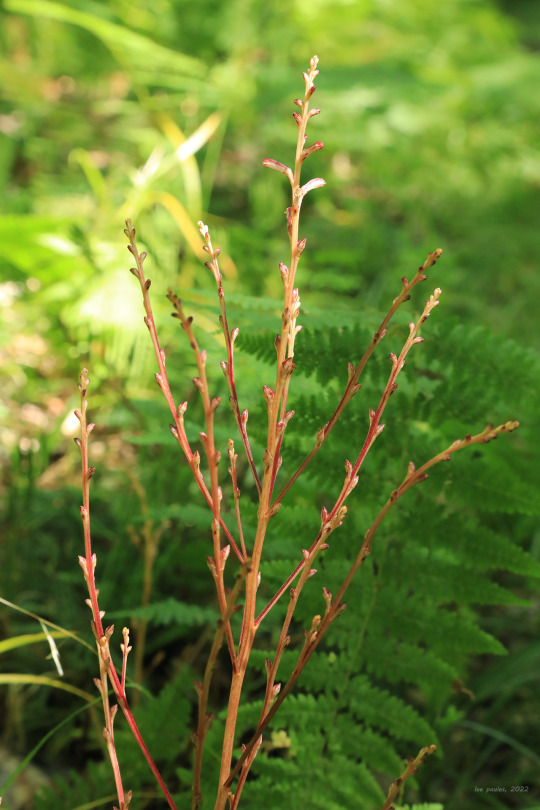
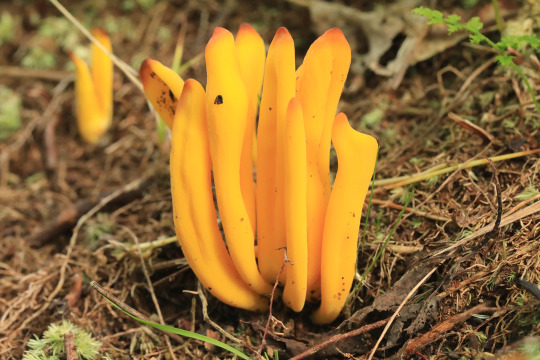





Canaan Valley National Wildlife Refuge, Part 1. Had Allegheny Power gotten its way 40 years ago, the land included as part of this idyllic refuge would today be the muddy bottom of a lake formed by damming the Blackwater River. The power company proposed turning the largest and most botanically-diverse high-elevation wetlands complex east of the Rocky Mountains into a “recreation destination” (e.g., overpriced tourist trap similar to nearby Deep Creek, Maryland) so it could execute a sketchy pump and release hydroelectric scheme. Thankfully, the US Army Corps of Engineers refused to issue a permit, and the nation has been since been rewarded with its 500th national wildlife refuge.
From top: beechdrops (Epifagus virginiana), a really unusual parasitic plant that draws its nutrients from the roots of the American beech tree; golden spindles (Clavulinopsis fusiformis), also known as spindle-shaped fairy club, a glorious late summer coral fungus; great spangled fritillary (Speyeria cybele), a common and lovely member of the Nymphalidae family that practically begs to be photographed; common milkweed (Asclepias syriaca), which blooms late into August at the higher elevation of the valley; Monarch larvae (Danaus plexippus), in their fifth instars; pearly everlasting (Anaphalis margaritacea), a fabulously-beautiful late summer aster much beloved by the dried flower industry; and the stingbean-like seed pods of Indian hemp (Apocynum cannabinum), one of the bittersweet bellwethers of summer’s end.
#appalachia#vandalia#west virginia#allegheny mountains#canaan valley#canaan valley national wildlife refuge#tucker county#epifagus virginiana#beechdrops#clavulinopsis fusiformis#golden spindles#spindle-shaped fairy club#speyeria cybele#great spangled fritillary#asclepias syriaca#common milkweed#danaus plexippus#anaphalis margaritacea#pearly everlasting#apocynum cannabinum#indian hemp#wildflowers#flora#summer
52 notes
·
View notes
Text

Visions of love—Indian hemp.
#indian hemp#plants#earth#mother earth#love#beauty#magic#plant magic#spicy#apocynum cannabinum#prairie dogbane#umi ananda
1 note
·
View note
Photo



Dreamy dogbane fields at the Pymatuning ecology lab
1 note
·
View note
Photo

Dogbane (by me)
#Dogbane#Apocynum cannabinum#Apocynum#Apocynaceae#Gentianales#flowers#plants#summer#Morris Canal Greenway#Morris Canal#Warren County#New Jersey#mine
13 notes
·
View notes
Photo

Apocynum cannabinum
#Apocynum cannabinum#wildflower#wild flower#wild flowers#wildflowers#flower#flowers#plant#plants#garden#gardening#gardens#nature#nature photography#photography
33 notes
·
View notes
Text
Tales From The Ditch...
Tales From The Ditch…
Hello everyone! I hope you are all doing well. We had more rain, up to 3 3/4″ through Thursday with more in the forecast. A few days ago I was trimming the ditch in front of what I always call the “other yard.” It is where my grandparent’s house was and where the garden is. Well, I didn’t plant the garden this year but that is beside the point. The part of the ditch in front of where the garden…

View On WordPress
#Ampelamus laevis (Honey-Vine Climbing Milkweed)#Apocynum cannabinum (Hemp Dogbane)#Convolvulus arvensis (Field Bindweed)#Euphorbia davidii (David&039;s Spurge)#Lathyrus latifolius (Bread-Leaved Pea/Everlasting Pea)
0 notes
Photo

Indian Hemp/Dogbane - Apocynum cannabinum. Kin to milkweeds (indeed it has its cousin's nasty latex making it a very toxic salad green), but interestingly it does not have pollinia like milkweeds, but essentially sticky pollen, that gets glued to visitors. If I read things right the pollen is not used to feed baby bees (this needs to be verified) and it is mostly a nectar attraction game. In the google literature claims of attractiveness to bees is all over the map, some way it attracts a lot and others say it is mostly a moth/butterfly thing. I can tell from lots of field experience that there is often almost nothing on these plants and then BOOM bees all over the place. My impression is that it is more used when nothing better is blooming (sort of the Raman Noodle of the bee plant world). Good plant to stick in an established cool season field as it seems (like common milkweed) to be able to handle the competition. Photo and specimen by Helen Lowe Metzman.
#indianhemp#dogbane#glib#fenti#simple#emotes#fingercuffs#slightlyhairy#greenery#orb#invite#seldom#allgood#ecology#usgs
21 notes
·
View notes
Text
My Garden Flowers Part 10
All photos mine, unedited. Not many at present because most of these haven't flowered yet! But they will and I will update. :)



In order of appearance:
271. Cow Parsnip (Heracleum maximum) Not pictured as she hasn't flowered yet.
272. Dutchman's Breeches (Dicentra cucullaria) Came free accidentally with my blue cohosh! I didn't intend to get this because unlike her cousin, squirrel corn, she has no known edible parts, but hey, free native plant that's pretty expensive. I'm not complaining. Not pictured as she hasn't flowered yet.
273. Blue Cohosh (Caulophyllum thalictroides) Not pictured as she hasn't flowered yet.
274. Witch Hazel (Hamamelis virginiana) Not pictured as I haven't got pictures yet.
275. Allegheny Blackberry (Rubus alleghaniensis) She did flower last year but only made one single berry each! Was kind of funny. Sadly there won't be any this year because the landlord cut her! (:
276. Showy Goldenrod (Solidago speciosa) Not pictured as she hasn't flowered yet.
277. Canadian Clearweed (Pilea pumila) She's kind of everywhere now, showed up with my jumpseed. Would likely be regarded as a weed in most places but I think she's cute.
278. Jumpseed (Polygonum virginianum) Not pictured as she hasn't flowered yet.
279. Green Dragon (Arisaema dracontium) Not pictured as I haven't got pictures yet.
280. Hemp Dogbane (Apocynum cannabinum) Not pictured as she hasn't flowered yet.
281. Yellow Avens (Geum aleppicum) Because although the yard is full of yellow-flowering avens, I'm pretty sure those are all bigleaf avens, and I wanted the other one too.
282. Lingonberry (Vaccinium vitis-idaea) Not pictured as she hasn't flowered yet.
283. Joepyeweed (Eupatorium maculatum) Not pictured as she hasn't flowered yet.
284. Alpine Sweetvetch (Hedysarum alpinum) Not pictured as she hasn't flowered yet.
285. Black-Fruited Sedge (Carex eburnea) Not pictured as I haven't gotten any pictures yet.
286. Early Blue Violet (Viola adunca) Not pictured as she hasn't flowered yet.
287. Giant Goldenrod (Solidago gigantea) I didn't plant that, but she's growing in numbers. lol Not pictured as she hasn't flowered yet.
288. Swamp Rose (Rosa palustris) Not pictured as she hasn't flowered yet.
289. Arctic Sweet Coltsfoot (Petasites frigidus) Not pictured as she hasn't flowered yet.
290. Great St. John's Wort (Hypericum ascyron) Not pictured as she hasn't flowered yet.
291. Lake Blackcurrant (Ribes lacustris) Not pictured as I haven't gotten any pictures yet.
292. Sweet Bedstraw (Galium triflorum) Not pictured as she hasn't flowered yet.
293. American Hog Peanut (Amphicarpaea bracteata) Not pictured as she hasn't flowered yet.
294. Arctic Raspberry (Rubus arcticus) Not pictured as I haven't gotten any pictures yet.
#blackswallowtailbutterfly#my photos#photography#my garden#garden flowers#native plant gardening#native flowers of Carolinian Canada and USA
5 notes
·
View notes